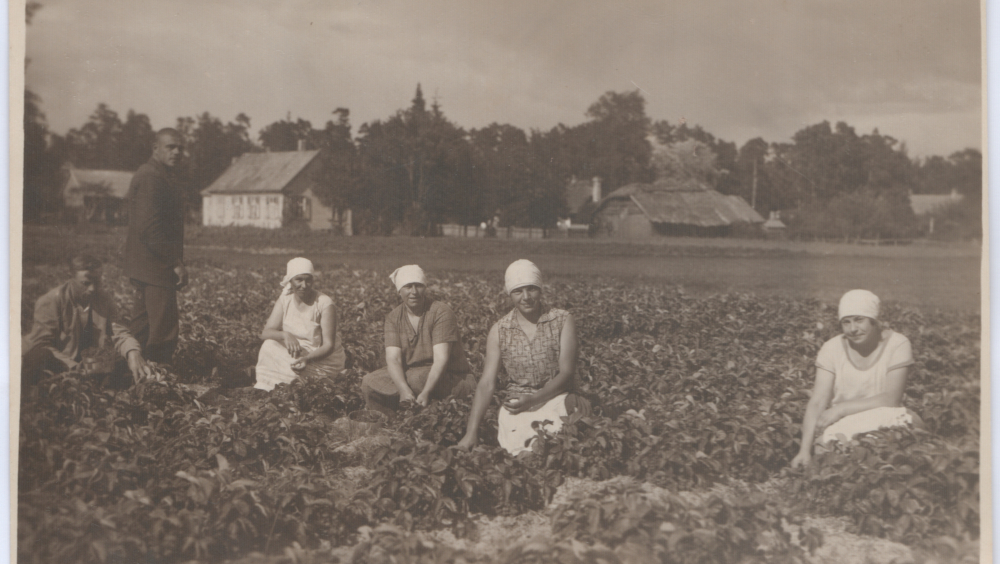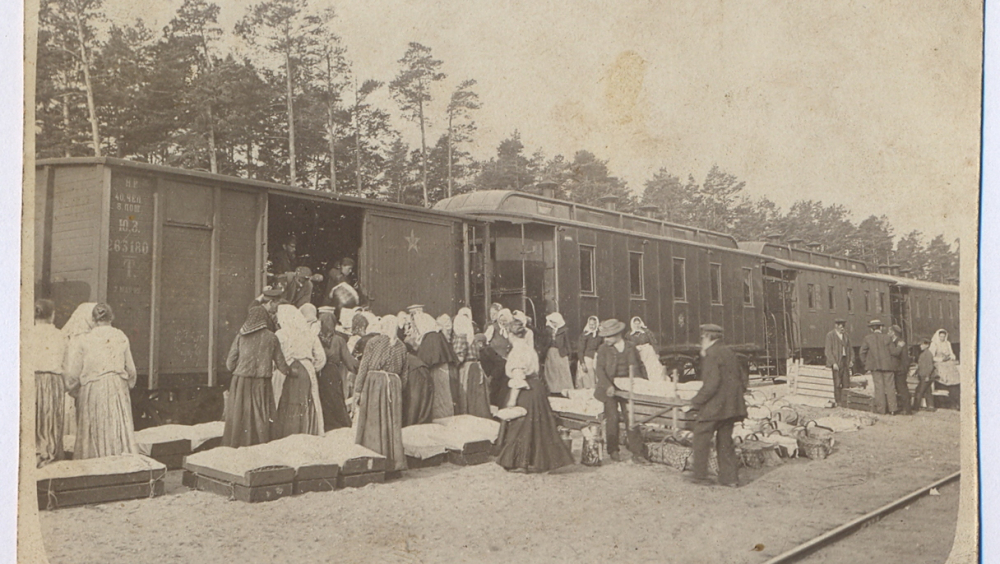Strawberry fields in Jūrmala
Strawberry Fields in Jurmala
Overview
Jurmala is the largest resort city in Latvia, about 25 kilometers west of the capital city of Riga. The area of the city is 100 km2. Jurmala stretches 24 km along the Gulf of Riga and the Lielupe river. In 2020, the city had a population of 49,687. The city traditionally consists of separate smaller towns that were once fishing villages, which then turned into seaside swimming spots in the beginning of the 19th century.
In 1877, in Rīgas Jūrmala (Rigasche Strand, Рижское взморье, nowadays - Jūrmala), garden strawberries started to be grown in Latvia. The plants were brought in from France by a man named Cortesie, who had a summer cottage there. He gifted the plants to several locals of Asari and Melluzi - two small districts of Jurmala (with an area of 6.2 square kilometers) which became the pioneering capitals of strawberry growing in Latvia, and later the whole Russian Empire (Latvia was part of Russia during this time period). The soil of the Asari and Melluzi districts was so favorable for strawberry seedlings, and the yields were so rich that the berries were transported to the Riga market by carts, river steamboats, and trains. While from 1900 to 1915, they were transported by special ‘’strawberry trains’’ from the small Asari train station to St. Petersburg. Growing and selling strawberries had allowed many locals to raise enough funds to have their children be able to get an education, by sending them to grammar schools and universities.
When Latvia gained independence (1918) and Jurmala was an internationally known seaside resort( 1920-s-30-s), strawberry growing continued to develop - cooperatives were formed, as well as the gardeners' association "Zemene" (Strawberry)- which educated gardeners, introduced new strawberry varieties from European countries and organized berry picking competitions. At the end of every autumn, owners of strawberry gardens went to the seashore to get seaweed for fertilizing their gardens, and sometimes a real "war" erupted over this fertilizer.
During World War II, with the onset of the Nazi occupation, strawberry growers were allowed to sell only a small portion of their harvest to the markets - everything else had to be handed over to the German army, but many took risks and were secretly selling in the markets. Often, the train carriages that drove from Asari to Riga were full of the aroma of strawberries - the strawberries were kept hidden in suitcases, and if inspection came to check - the cases were thrown out of the window.
During the Soviet occupation, all strawberry orchards were nationalized and the former owners were able to keep a small portion of their harvest for sale, while everything else had to be handed over to an agricultural cooperative for a small fee. After the restoration of Latvia's independence, strawberry growing in Jurmala declined because local berries could not compete with the much cheaper Spanish and Polish strawberries. However, stories about ancient strawberry fields still remain there, as well as the desire to preserve these stories and create a community garden with ancient strawberry varieties.
The Strawberry fields in Jūrmala
In 1877, in Rīgas Jūrmala (Rigasche Strand, Рижское взморье, nowadays - Jūrmala), garden strawberries started to be grown in Latvia. The plants were brought in from France by a man named Cortesie, who had a summer cottage there. He gifted the plants to several locals of Asari and Melluzi - two small districts of Jurmala (with an area of 6.2 square kilometers) which became the pioneering capitals of strawberry growing in Latvia, and later the whole Russian Empire (Latvia was part of Russia during this time period). The first variety to be cultivated here was "Victoria", named in honor of the Queen of England. Later, several varieties of strawberries were also imported from Germany. The local sub-variety of "Victoria" was soon formed in Rigas Jurmala. The soil of the Asari and Melluzi districts was so favorable for strawberry plants, and the yields were so rich - that the berries were transported to the Riga market by carts, river steamboats, and trains. While from 1900 to 1915, the berries were transported by special ‘’strawberry trains’’ from the small Asari train station to St. Petersburg. The strawberries of Jurmala had gained so much attention due to the particular nuance of their sweet
and sour taste.
The demand for berries in Rigas Jurmala itself was also high because Rigas Jurmala was a well-known seaside resort. And so vacationers, local restaurants, and confectioneries were glad to buy the berries.
In order for the soil to have proper fertilization, strawberry-growing families kept one or two cows. Growing and selling strawberries had allowed many locals to raise enough funds to have their children get an education, by sending them to grammar schools and universities. Many well-known artists, scientists, and writers in Latvia have been able to study thanks to this "strawberry money".
Until the big “strawberry boom”, the main occupation of the inhabitants of Asari and Melluzi was fishing. In the summer - they fished at sea, while in the winter - the fishermen went to the lakes of Kurzeme (west of Latvia), where they engaged in ice fishing. While being on a trip to Kurzeme, a fisherman named Jēkabs (Jacob) from Melluzi, fell in love with a beautiful girl named Matilde. He married her and Matilde started working on their home in Melluzi. Matilde was very hardworking and just like many other locals - she grew strawberries. She began working in the garden at sunrise. The fishermen also went to the sea in the early hours of the morning. But when they got to Matilde's garden, they turned around and went back home, where they often spent the rest of the day with a strong drink - Since the olden days, fishermen have believed that if a woman is first encountered before fishing, there will be no fish in their nets. As this had happened time and time again, the neighbors' wives asked Matilde to come to the garden a little later, so that the fishermen could go to the sea without having seen her.
In the traditional berry growing districts of Jurmala in the 1930s - Melluzi, Asari and Valteri - there were about 300 hectares of berry orchards, which gave about 660–830 thousand kilograms of different berries per year - most of them being strawberries. In 1923, the horticultural association "Zemene" was founded in Jurmala, which popularized berry growing and supported growers. The association distributed plant catalogs, gave lectures introducing the latest varieties of European strawberries, and organized a strawberry picking competition - the participants (usually women) who could pick the highest quality berries at the fastest pace - won prizes.
Since the end of the 19th century, strawberry growers had used seaweed to fertilize strawberry fields. They were usually collected with rakes after major autumn storms when large waves washed them ashore in large quantities. Gardeners went to the seafront early in the morning and used two rakes to enclose the plot from which they wanted to collect the "sea manure". Those who had not arrived early enough were forced to go very far along the beach coastline (in Jurmala, it’s 24 kilometers long), and this meant problems with transporting the fertilizer to their garden. Disputes often took place. One time, a clever local of Asari, wearing fishermen’s boots and a long rake in his hands - grabbed the seaweed from the water and replied to the protests of the neighbors: "As long as the manure is in the water, it does not belong to anyone!".
Once the seaweed was collected, it was piled up in high piles at the top of the dunes, where it had to be "burned out" by springtime, when it was then taken to gardens by carts. A curious boy, wanting to know how this "sea manure" can burn - since no one burns it, put his hand under the pile - the heat truly was so great that he then immediately pulled his hand out.
During World War II, with the onset of the Nazi occupation, strawberry growers were allowed to sell only a small portion of their harvest to the markets - everything else had to be handed over to the German army, but many took risks and were secretly selling in the markets. Residents of Riga came to the strawberry growers and bought the berries that they had previously agreed upon buying. A great deal of trouble could come from this - ranging from fines to concentration camps. Often, the train carriages that drove from Asari to Riga were full of the aroma of strawberries - the strawberries were kept hidden in suitcases and placed on luggage racks. If the gendarmes came and asked who owned the suitcases, the passengers shrugged - and then the gendarmes simply threw these suitcases out of the window…
During the Soviet occupation, all strawberry orchards were nationalized, and the former owners were able to keep a small portion of their harvest for sale, while everything else had to be handed over to an agricultural cooperative for a small fee. The most popular variety was "Senga - Sengana", while in the 1970s, the old "Victoria" was still being grown - the very first variety that was once grown in Jurmala. After the restoration of Latvia's independence (1991), strawberry growing in Jurmala declined because local berries could not compete with the much cheaper Spanish and Polish strawberries. However, there is a Strawberry Street (‘’Zemeņu iela’’) in Asari-Melluzi, and stories about ancient strawberry fields still remain there, as well as the desire to preserve these stories and create a community garden with old types of strawberry varieties.
The European Dimension
In our story, the European dimension can already be found in its source - the cultivation of strawberries in Jurmala began due to the interaction between different countries and nationalities. We currently want to set up a project that incorporates the guidelines of the European strategy for cultural heritage, an inclusive approach involving all cultural agents - including professionals, NGOs, volunteers, children, and the youth. Together with the staff of the Jurmala City Museum, the locals will create an exhibition on the history of strawberry growing, and the students of the Jurmala Art School will make an animation film. Alongside the Children and Youth Center, we will also create a community garden where old types of strawberry varieties will be grown. We are inspired by similar projects created by the museums in Frankfurt am Main and Lisbon, and we intend to cooperate and consult with them. Exchange of exhibitions is also possible. The project also includes publications and media coverage. In addition to this, the project will also create a new tourist route that can be used by the city of Jurmala. We have invited specialists who will help involve people with special needs in the project. People of many different backgrounds live in Jurmala, and the city is visited by numerous tourists. Our project will be designed to promote intercultural dialogue and respect for identity and diversity, as well as a sense of belonging to a community that is based on values.
Project legacy
Budget Breakdown

